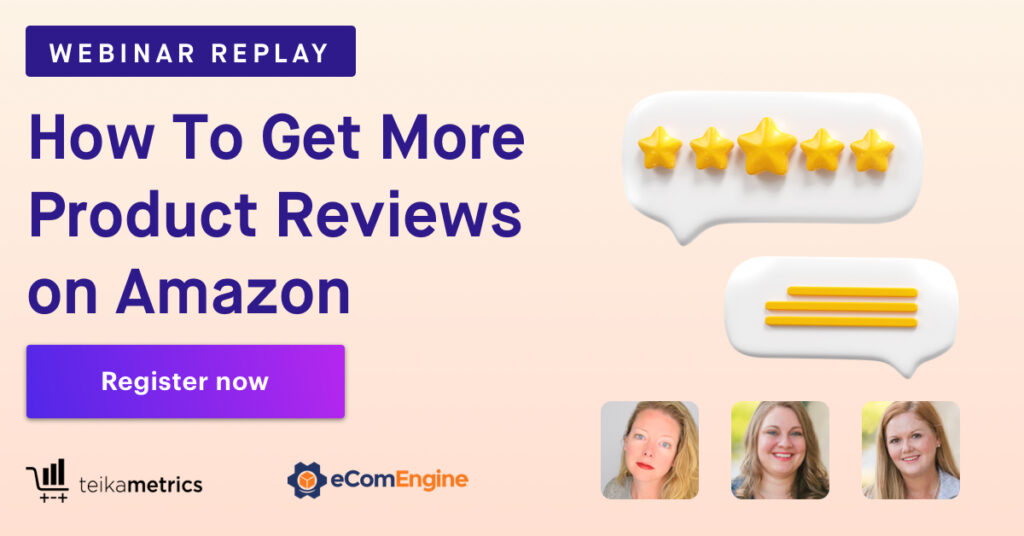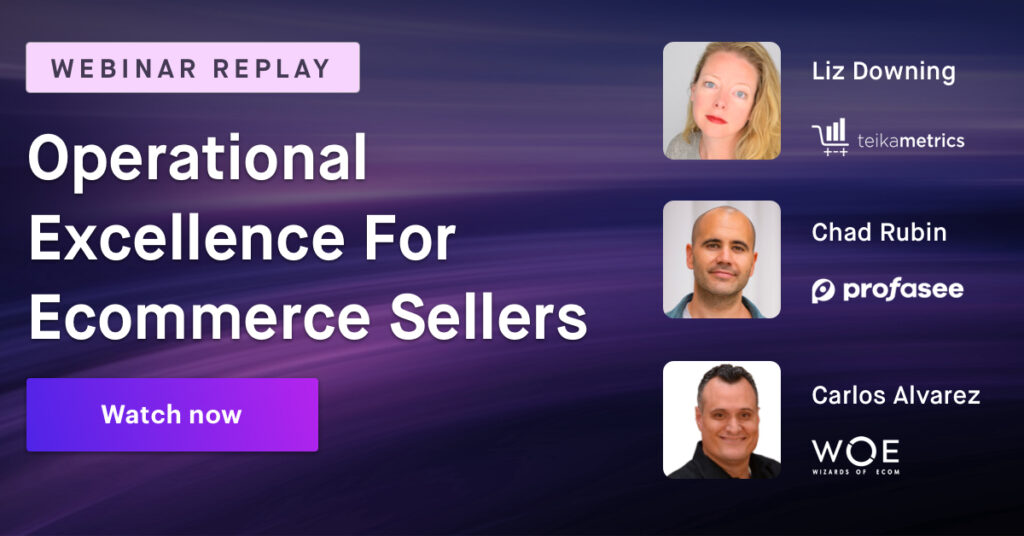Aggregators are firms that seek to acquire other businesses. In 2021, there was a big investor appetite for aggregators, allowing for many successful exits. But behind the scenes, there are numerous factors that go into a successful acquisition. TJ Hyland is the Director of Global Partnerships at Elevate Brands, an aggregator that specifically looks to acquire businesses that buy and sell on Amazon in order to continue to operate and grow them. In the past two years, they have acquired 30+ businesses. TJ joined Jason Magee, Senior Director of Sales at Teikametrics, for a deep dive into lessons learned in the past year that sellers can use as they plan for 2022.
Webinar Teika-ways
- Set up an accrual accounting system
- Take the LOI process seriously
- Don’t stop ordering inventory
- Consider multiple sale types
- The value of second exits
Show Links
- Check out Elevate Brands
- Connect with TJ Hyland on LinkedIn
- Connect with Jason Magee on LinkedIn
- Check out Teikametrics
- Connect with Teikametrics on Twitter or LinkedIn
- Register for AdMax
Watch the Full Replay:
Key Teika-ways
10:35 – Set up an accrual accounting system
TJ says that now is a great time to consider a strong accounting system that will paint a clear and accurate picture of your financials should you choose to sell your business down the road.
“It’s never too early to put your business in a good position. The number one thing that businesses come to us and kind of do not have a good grasp on is their financials. And whether that’s because they started as just themselves as a side job and they never really took it seriously and now they’re actually running a multi-million dollar business off Excel sheets, that’s not really good. Because when you go to approach somebody that’s going to want to pay you multimillion dollars for your business, they’re going to want a little bit more context than that. The other thing that we see often is a lot of businesses are running off cash accounting, whereas for their benefit and ours, in terms of evaluating a business they really shouldn’t be running on accrual accounting. And the difference really lies in the timing of where the sales and the purchases are recorded in your accounts. So the biggest difference is that accrual accounting portrays a more accurate portrayal of the company’s health, because it includes your accounts payables and accounts receivables, whereas cash accounting is more sort of time of transaction.”
17:17 – Take the LOI process seriously
When Elevate Brands issues an LOI to a client, it means they are 100% committed to the purchase. Only an extenuating circumstance would cause them to withdraw the offer.
“We do most of our due diligence upfront. We will ask all those questions before actually issuing an LOI. Because what do you have to think is these are generally people’s babies, right? They grew them from nothing to now something really nice. And they have employees and families and everything that might benefit from the sale of this business. So we take LOIs incredibly seriously. With this letter of intent, the intent of us to pay you X, Y, Z over X many years or however the structure will be. There’s only been one time in which we’ve backed out of an LOI, issuing 50 to 60 to 70 to 80 and 90 of them. Sometimes the seller backs out because they accept a different LOI, that’s a different situation. But if we issue an LOI, unless something drastic happens we really want to go through with that. Because you don’t want to be messing with the seller. It’s a mentally straining activity to be selling your business, and emotional.”
19:48 – Don’t stop ordering inventory
A common misconception is that when you are preparing to sell, you can stop doing regular business tasks such as ordering new inventory. In reality, you should continue to run your business as usual.
“Do not stop ordering inventory. You cannot sell your business if you have no inventory. For a number of the issues you just talked about with the supply chain, if we buy your business today and there’s enough inventory to last for one month. And you haven’t placed that next order yet and that order takes 90 days to get here, that means we just bought a business that’s going to sit empty, probably lose the Buy Box, lose all the rank for those two months, and kind of start at ground zero again. So from our perspective, when we go to acquire a business, if you have inventory on hand, that will be visible in your P&L statement. You will absolutely get the value of that inventory back…You basically have to continue to operate your business as if you were we’re going to be owning it. Because somebody is going to be buying it and someone’s going to be continuing to run it.”
26:18 – Take the pandemic into account
When determining what your business is worth in light of the ups and downs of the pandemic, TJ says there are ways to account for the fluctuations, such as with “earn-out” bonuses post-sale.
“In the deal structure, a lot of the times you’re paid on the day of closing for what your business has done. And then there’s a structure in which you get that plus an earn-out. So you get a percentage based on how the business grows over the next year or two years or three years. And obviously, that’s a different situation for every business. So if you were in a bit of a hole for say 2021, but you know that if you had proper inventory that you would be able to supersede any sort of expectations, you would benefit from the fact that you had an earn-out. And you would benefit some of the growth of the business.”
27:48 – Consider multiple sale types
When selling your business to a company like Elevate, you can sell it in full, as a joint venture, or as a partnership.
“We’re flexible in deal structure. We do 100% acquisitions, absolutely. If the seller wants to sell and we don’t need them and they don’t want to be involved, they want to take their money and go to the beach, cool. They can do that. We do joint ventures, which is a 50-50 split, which are sometimes a little bit more complicated in terms of the legality side of things and figuring out what roles and responsibilities are. But one of our most successful brands is actually a joint venture that has grown pretty significantly. That was done in early 2020, and we’re actually about to close another joint venture. It’s a really nice brand as well. And then the third type is a partnership, where Elevate would acquire a majority of the business, and then leave 20 to 30 to 40% of the business for the original owner to continue to operate the business typically, in some capacity. But then also have the opportunity for that second exit, to sell the remaining portion that they own.”
34:20 – How multiples work
TJ breaks down exactly what it means when someone says they sold their business for “3x” or another multiple.
“Multiples are a number that you would multiply times essentially what is the core value of your business, in terms of profit. What we typically call it is SDE, which is stands for Seller’s Discretionary Earnings. A more common term in the M&A industry is EBITDA, which stands for earnings before interest, tax, depreciation, and amortization. So basically what both of them are doing is providing a snapshot of the business’s operational efficiency, as well as the profitability. It’s not a be all end all, but why we prefer to go at SDE is because, from a seller’s perspective, there are a little bit more things that you would write out that wouldn’t be part of the value of your business, right? Like if you have a company car, if you have this warehouse space that we’re not going to take over, if you have a number of these other things. There’s a little bit of a difference in terms of what sellers do and how sellers value their business. So that’s why we prefer to go with SDE. And then when we talk about the EBITDA or SDE and the multiple, the multiple is times that number. So for example, if your business was doing a million dollars revenue and your SDE was $250,000, your multiple would be times that $250,000. So say you got a 4x multiple, that means that your payday would be around a million dollars for your business.”
43:54 – Average offers in today’s M&A market
The M&A market is hot and shows little signs of slowing down. TJ says that the best offers he’s seen have been 6x multiples.
“We’re not looking to flip businesses. We want to buy them, continue to operate them, and grow them and make a large consumer goods product business. Whereas some of the other aggregators in this space want to buy a business and pay 3x or 4x, build it up, and then sell it for 8x, whether it’s as an individual business or as a whole portfolio. And we’re starting to see some of that as well. And to your point on multiples, like I said, right now our average that we see is more in the 4-6x range. We’ve said that we think that they’re going to sort of plateau a little bit, but at the same time, I still see some offers come across with 7-8x. I would like to think that it’s going to slow down, but I really have no belief that it’s going to. And that being said, if you could get 6x for your business today, that’s the highest I’ve ever seen it as of today.”
46:23 – The value of second exits
When owners choose to stick around after a sale as part of a partnership, Elevate incorporates what is called “second exit” terms that would allow the owner to sell the remainder of the business when they’re ready.
“The first multiple, what we call like sort of the upfront, is pretty standard. That is what you are walking away with today when we sign this agreement and the funds go into escrow. That’s kind of upfront. What we like to do is if it’s a partnership where the original owner is staying on, is to make sure that the second exit is at a higher multiple, right? Because then you, as the business owner, are even more incentivized to grow that business. Where you have your money, you have your payday, fine. Now you’re working in conjunction with Elevate, with our shared resources. And in theory, you can do more, buy more inventory, grow the business faster. And say in two years, you have already agreed upon multiple upfront of where you can have that second exit. And why we do that with partnerships is especially if you own 30% of a business and we own 70%, we like to give the owner today when we sign the agreement the opportunity to have that second exit in place. Because who’s going to want to buy 30% of a business, right? Another private equity business or another aggregator is not going to come buy 30% of the business.”
52:16 – Implement good advertising systems
Advertising systems should not be overlooked when preparing your business for a sale. The better the systems, the less legwork an acquiring company needs to do.
“We absolutely want them to have systems. Whether it’s a manual person on their team or a solution like Teika or somebody else, what that does is eliminate a lot of the legwork for us. It allows us to, especially with Teika, see what keywords are working, what’s not working. It gives us a massive time savings on what we can spend our time doing. When we do acquire a business, day one we do deep dives into the listings, checking all the keywords, the campaigns. How can we improve conversion without changing too much? There’s a whole growth plan that we talk about on what do you do day one, month one, Q1, and then ongoing. And the easiest thing, as you said, is even if a business is using XYZ software or someone in house, they want to be able to show how we can take that business to the next level.”
53:50 – Why Elevate values Teikametrics
The big-picture view of advertising that Teikametrics provides is extremely valuable for Elevate to use when evaluating business opportunities.
“Teika gives a really good holistic view of the business. I think you used that word earlier, and it’s true. And I think it’s more than just here’s this, here’s that. The reporting is really good. And it allows us even before we acquire the business, as part of our due diligence of they’re using Teika, it really helps us understand how is the ad spend affecting say organic sales or paid sales, and whether it’s being successful. And which keywords work and which are not working. It’s more than some companies that are kind of siloed in what they do. And this is kind of overarching and gives a wide range of different things that we can look at to evaluate the business. I think that’s probably more used in evaluating the business, and then ongoing in terms of different levers to pull that are working. To say, this is working, why stop?”





